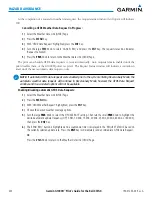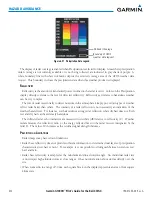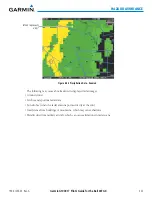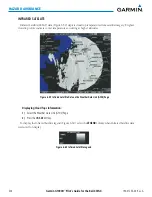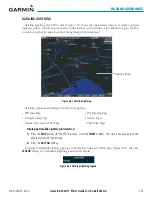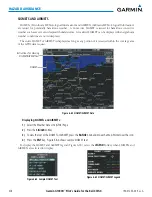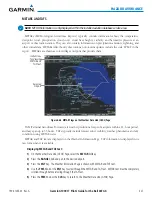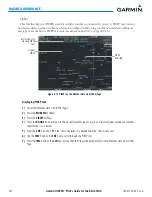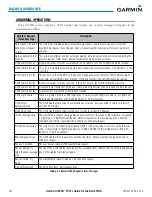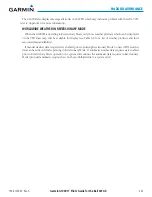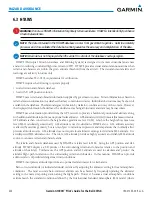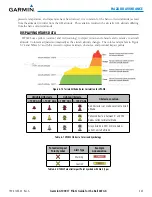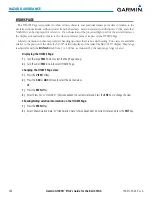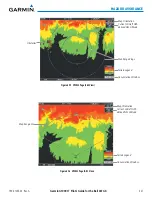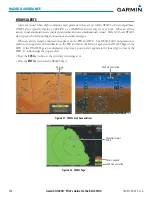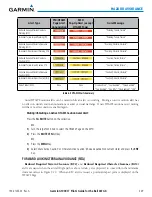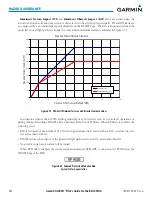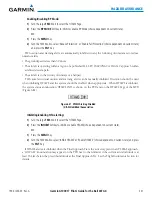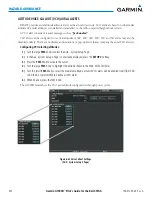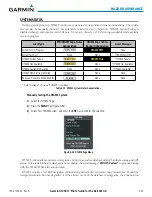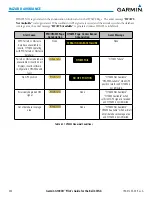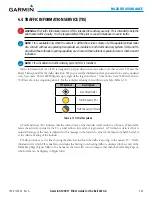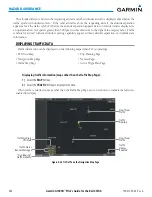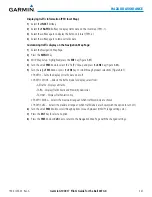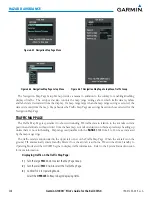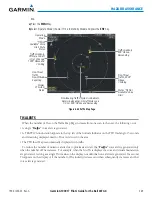
Garmin G1000H
™
Pilot’s Guide for the Bell 407GX
190-01255-00 Rev. A
334
HAZARD AVOIDANCE
6.3 HTAWS
WARNING:
Do not use HTAWS information for primary terrain avoidance. HTAWS is intended only to enhance
situational awareness.
NOTE:
The data contained in the HTAWS databases comes from government agencies. Garmin accurately
processes and cross-validates the data but cannot guarantee the accuracy and completeness of the data.
NOTE:
Terrain data is not displayed when the aircraft is outside of the database coverage region.
HTAWS (Helicopter Terrain Awareness and Warning System) is designed to increase situational awareness
and aid in reducing controlled flight into terrain (CFIT). HTAWS provides visual and aural annunciations when
terrain and obstacles are within the given altitude threshold from the aircraft. The visual and aural alerts and
warnings are advisory in nature only.
HTAWS satisfies TSO-C194 requirements for certification.
HTAWS requires the following to operate properly:
• A valid terrain and obstacle database
• A valid 3-D GPS position solution
HTAWS uses terrain and obstacle information supplied by government sources. Terrain information is based on
terrain elevation information in a database that may contain inaccuracies. Individual obstructions may be shown if
available in the database. The data undergoes verification by Garmin to confirm accuracy of the content. However,
the displayed information should never be understood as being all-inclusive and data may be inaccurate.
HTAWS uses information provided from the GPS receiver to provide a horizontal position and altitude, along
with additional altitude input from an optional radar altimeter. GPS altitude is derived from satellite measurements.
GPS altitude is then converted to the height above geodetic sea level (GSL), which is the height above mean sea
level (MSL) calculated geometrically. GSL altitude is used to determine HTAWS alerts. GSL altitude accuracy
is affected by satellite geometry, but is not subject to variations in pressure and temperature that normally affect
pressure altitude sensors. GSL altitude does not require local altimeter settings to determine MSL altitude. It is
a widely-used MSL altitude source. Therefore, GSL altitude provides a highly accurate and reliable MSL altitude
source to calculate terrain and obstacle alerts.
The terrain and obstacle databases used by HTAWS are referenced to MSL. Using the GPS position and GSL
altitude, HTAWS displays a 2-D picture of the surrounding terrain and obstacles relative to the position and
altitude of the aircraft. Furthermore, the GPS position and GSL altitude are used to calculate and “predict” the
aircraft’s flight path in relation to the surrounding terrain and obstacles. In this manner, HTAWS can provide
advanced alerts of predicted dangerous terrain conditions.
HTAWS incorporates altitude input from an optional radar altimeter for certain alerts.
Baro-corrected altitude (or indicated altitude) is derived by adjusting the altimeter setting for local atmospheric
conditions. The most accurate baro-corrected altitude can be achieved by frequently updating the altimeter
setting to the nearest reporting station along the flight path. However, because actual atmospheric conditions
seldom match the standard conditions defined by the International Standard Atmosphere (ISA) model (where
Summary of Contents for G1000H
Page 1: ...G1000H Integrated Flight Deck Pilot s Guide Bell 407GX ...
Page 2: ......
Page 146: ...190 01255 00 Rev A Garmin G1000H Pilot s Guide for the Bell 407GX 134 AUDIO PANEL AND CNS ...
Page 518: ...190 01255 00 Rev A Garmin G1000H Pilot s Guide for the Bell 407GX 506 APPENDIX B Blank Page ...
Page 540: ...Garmin G1000H Pilot s Guide for the Bell 407GX 190 01255 00 Rev A I 6 INDEX Blank Page ...
Page 541: ......

